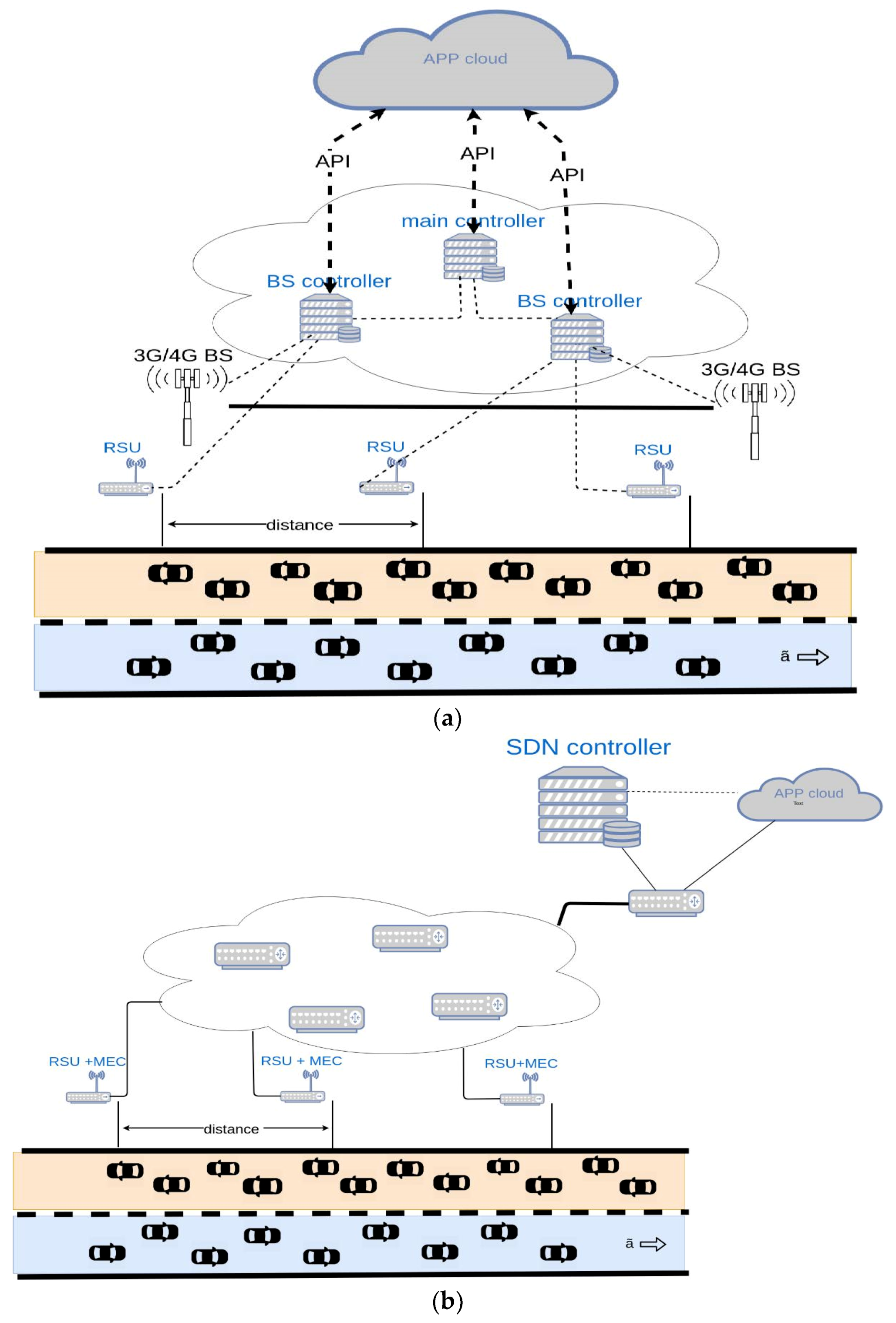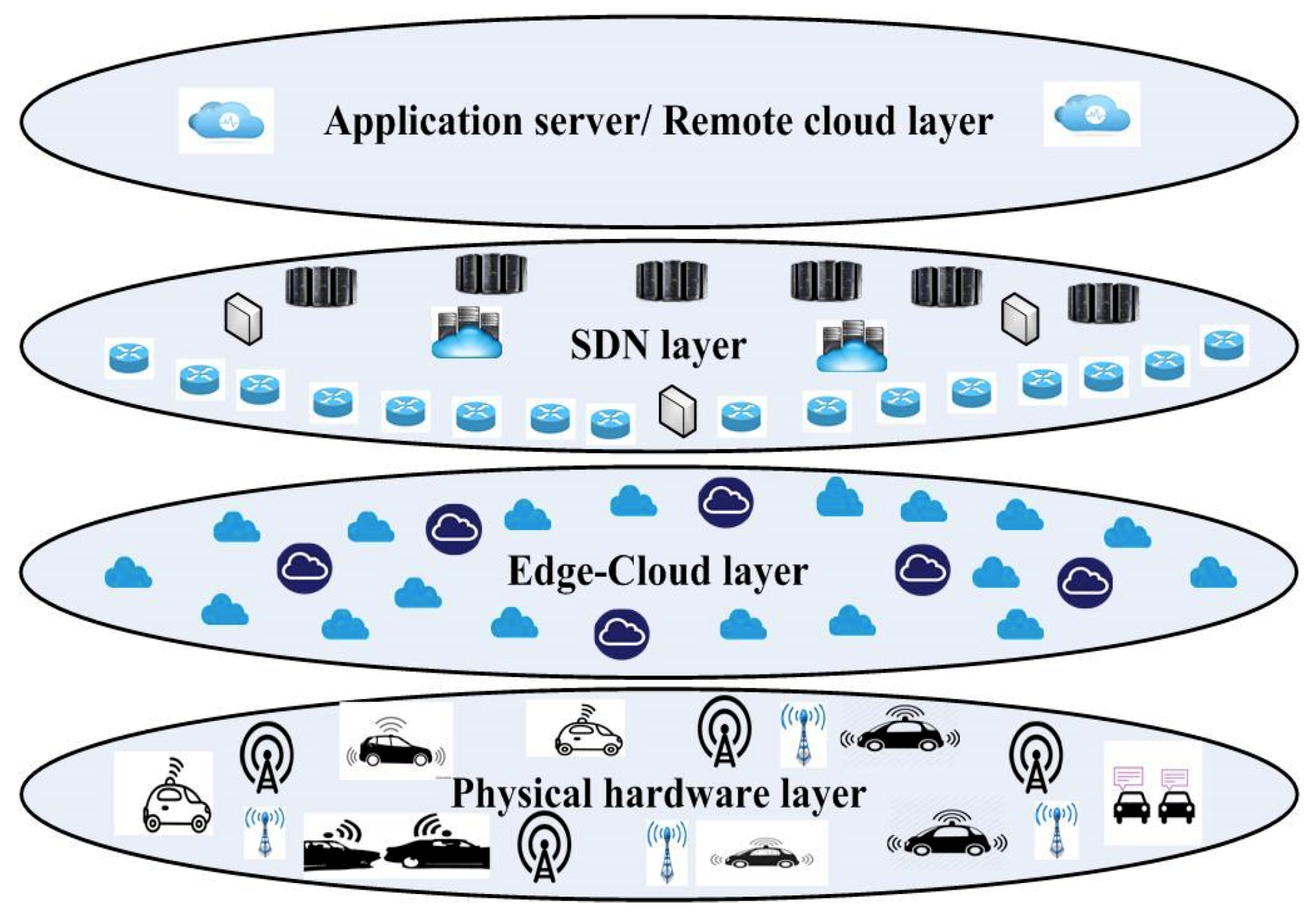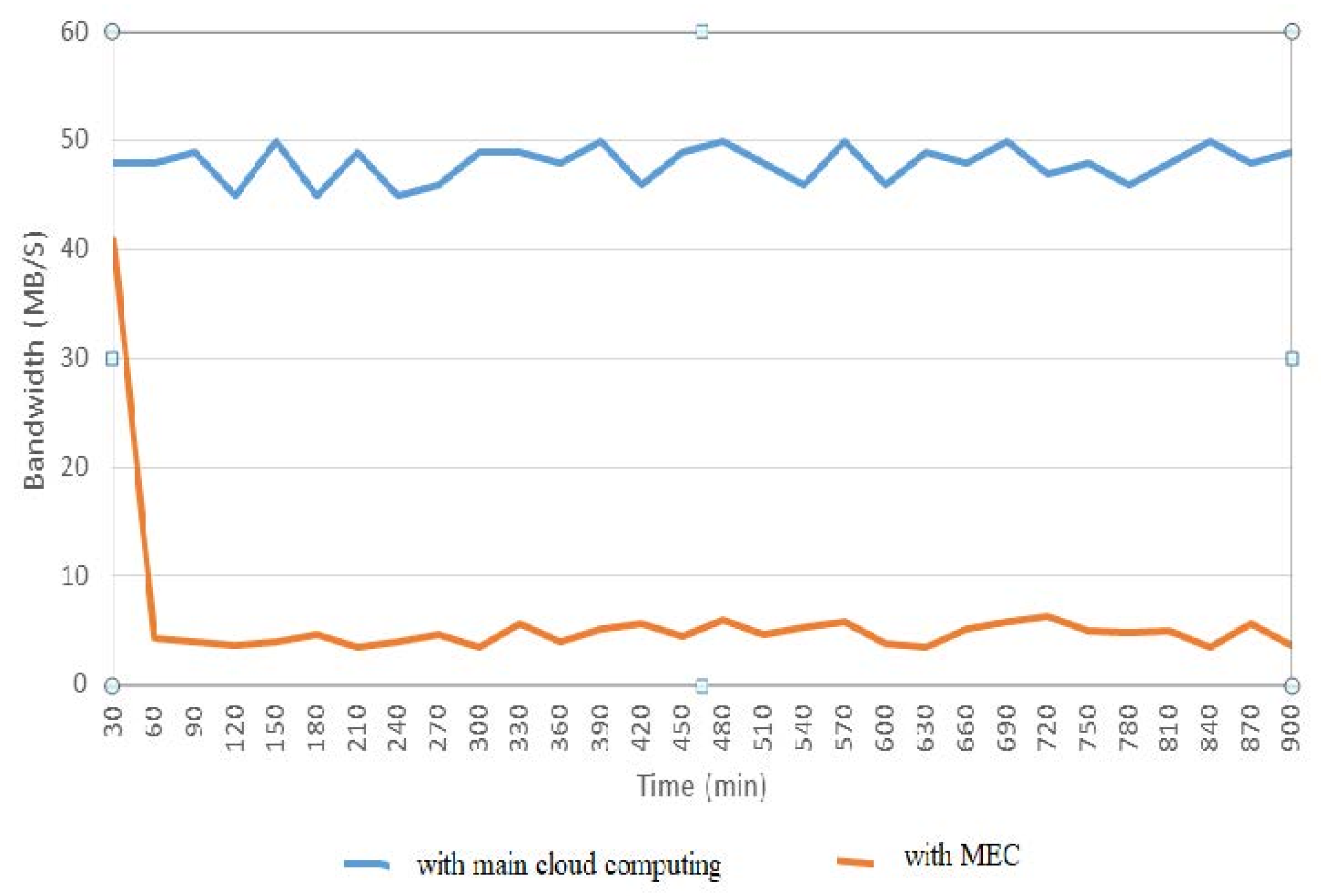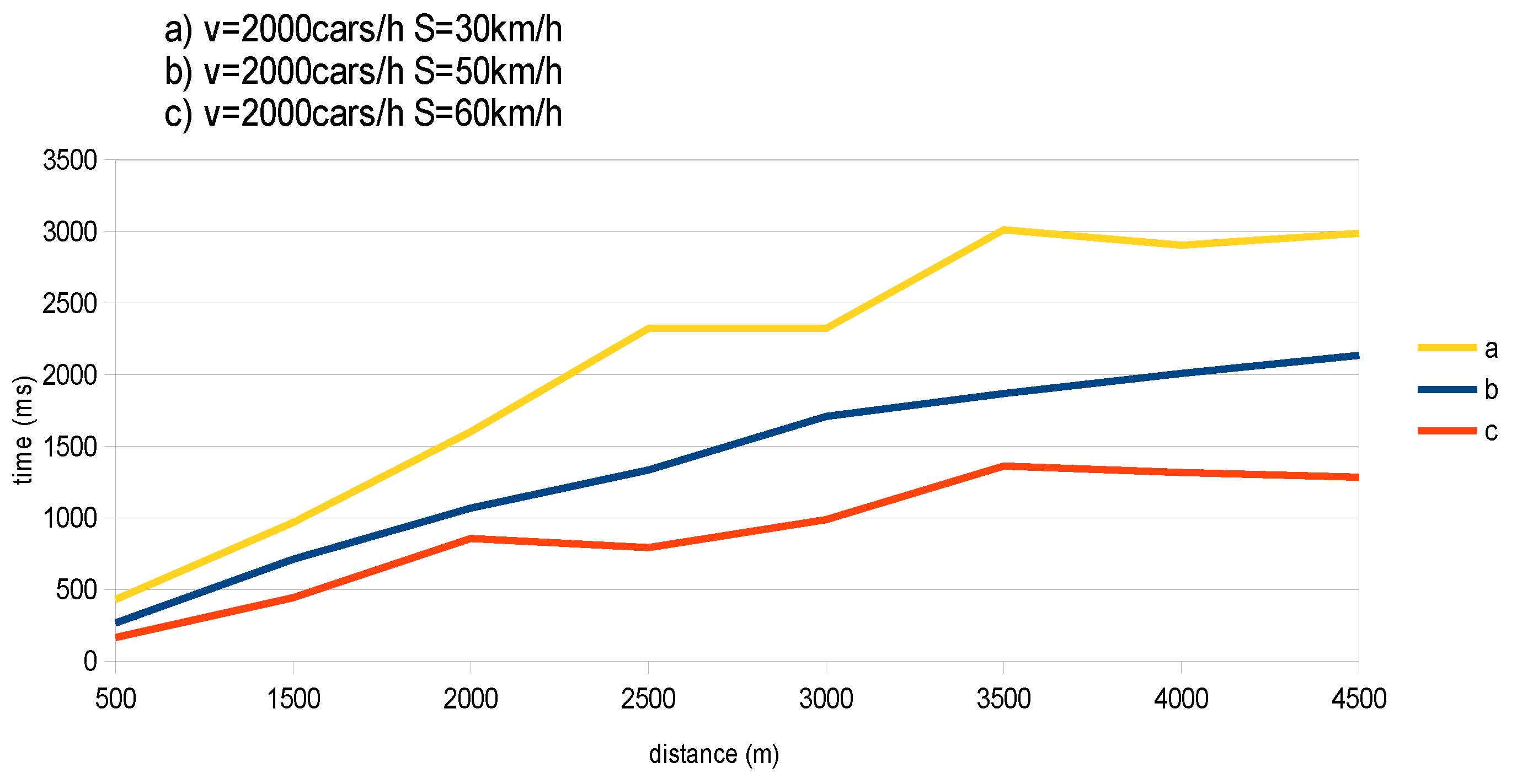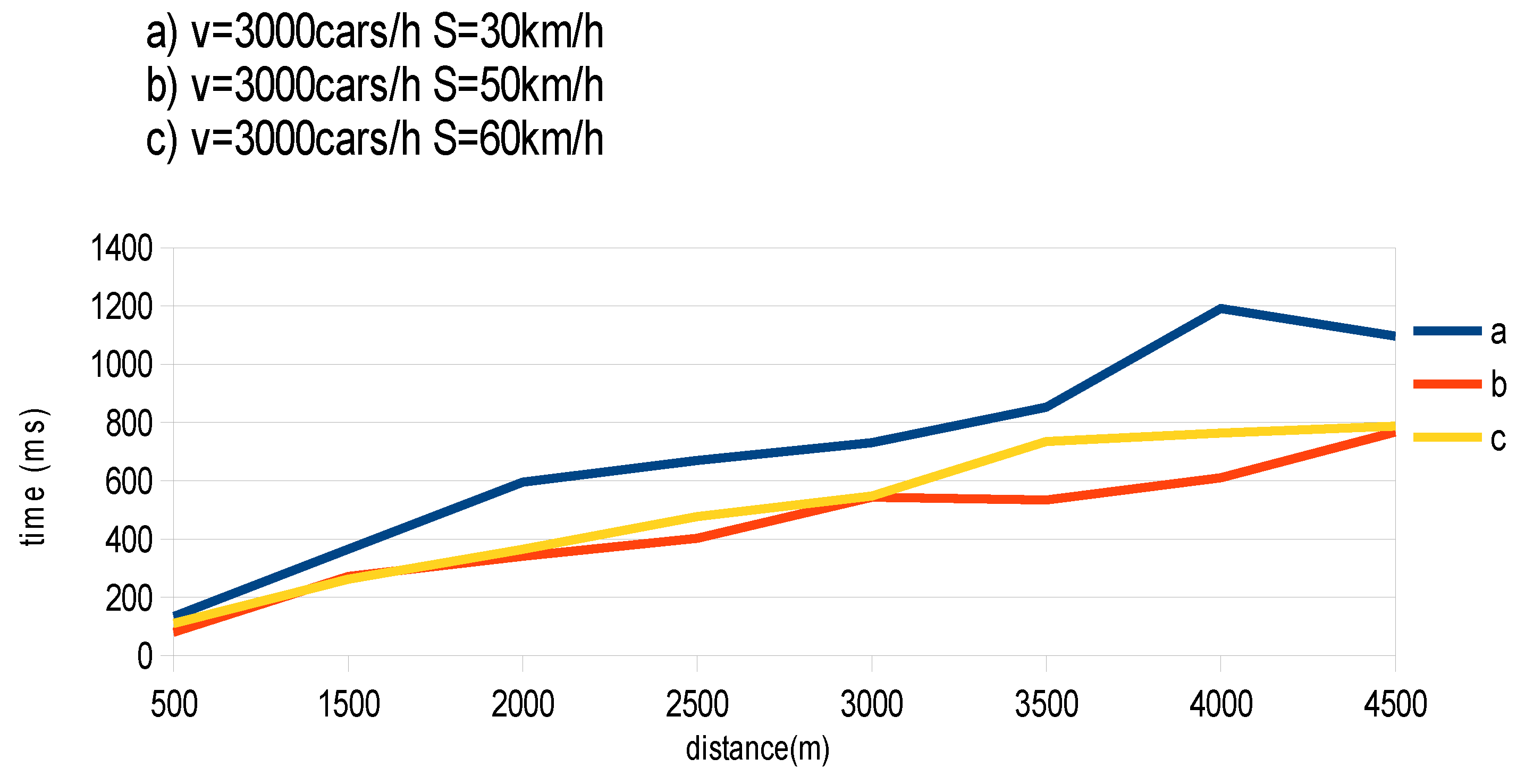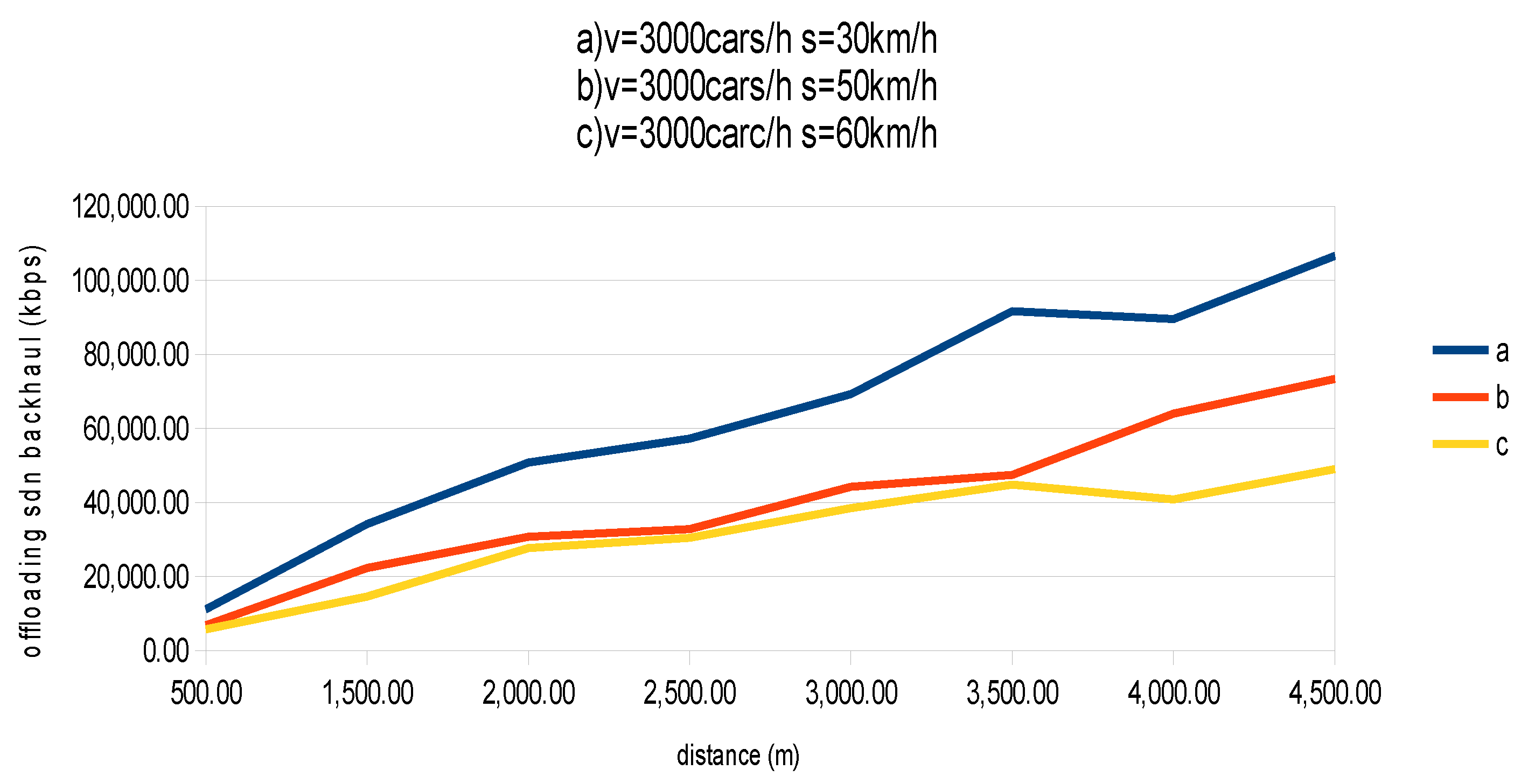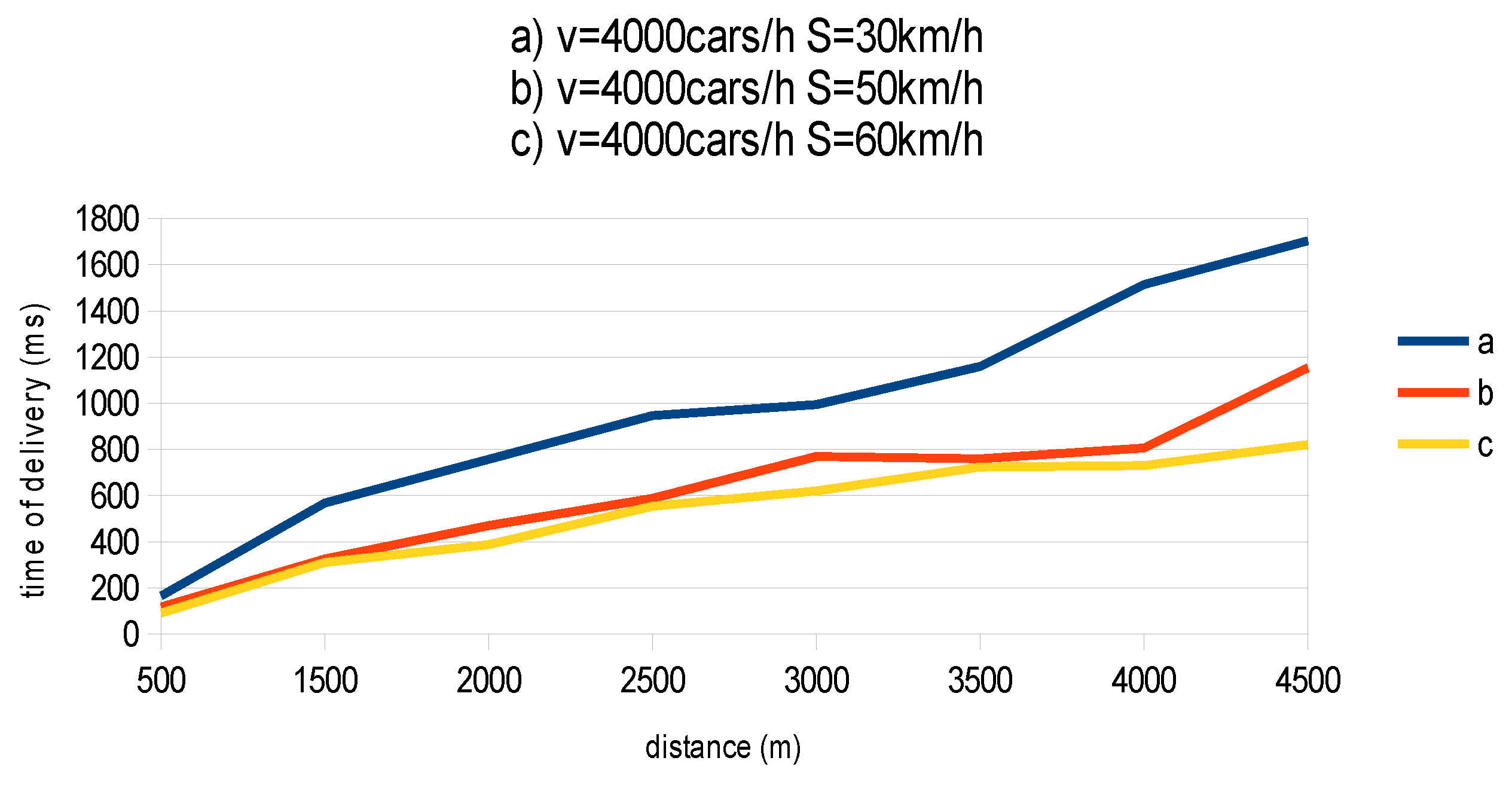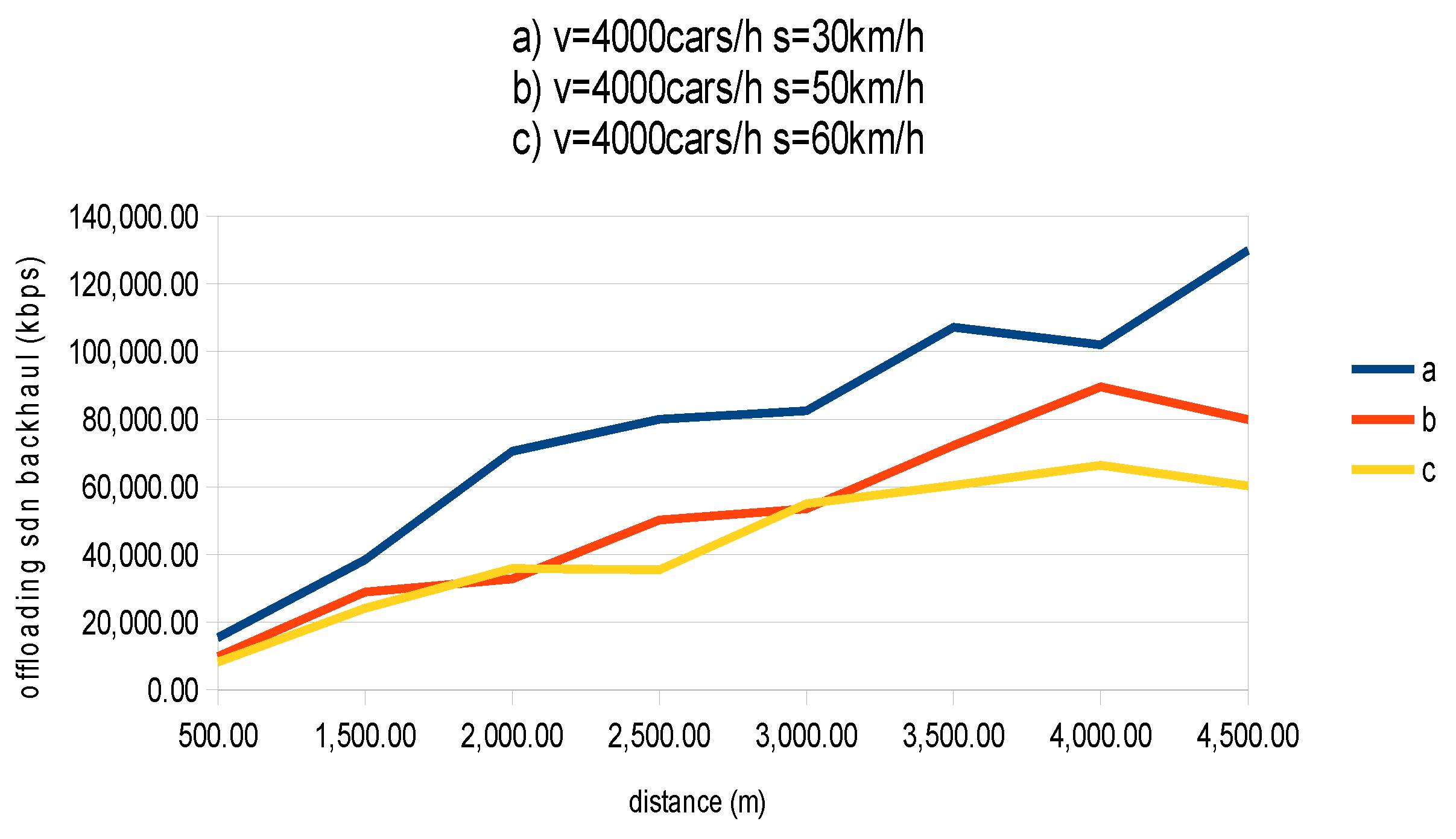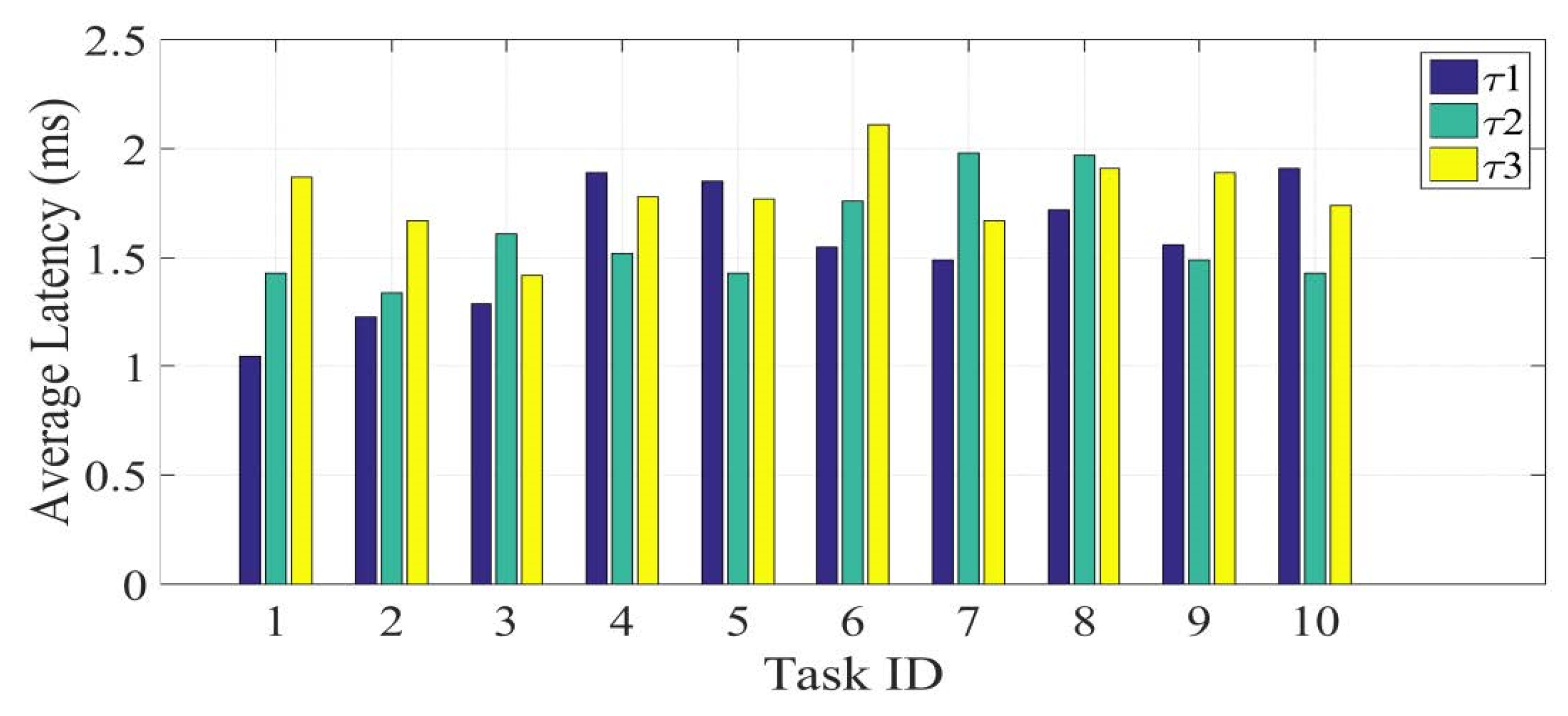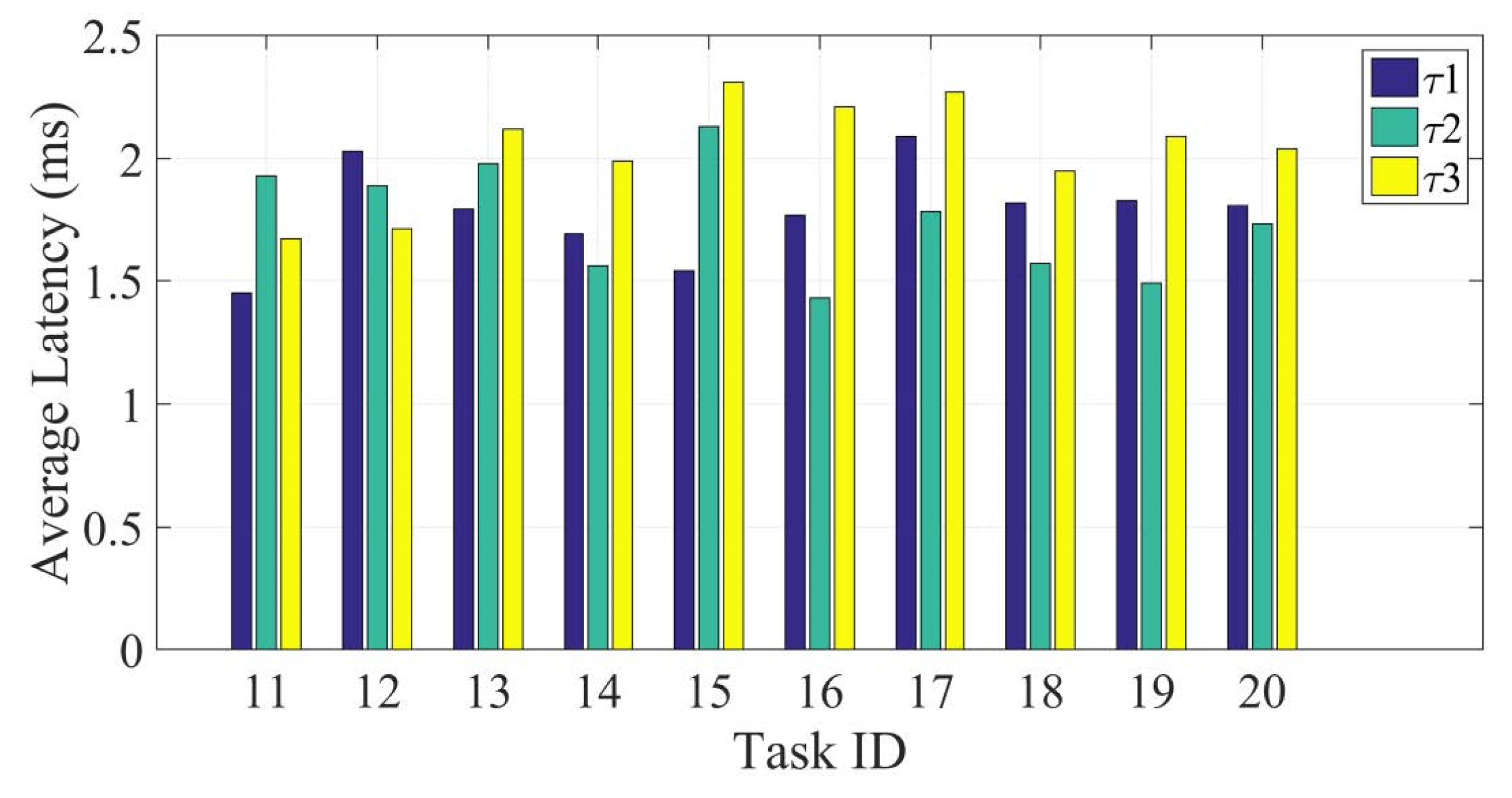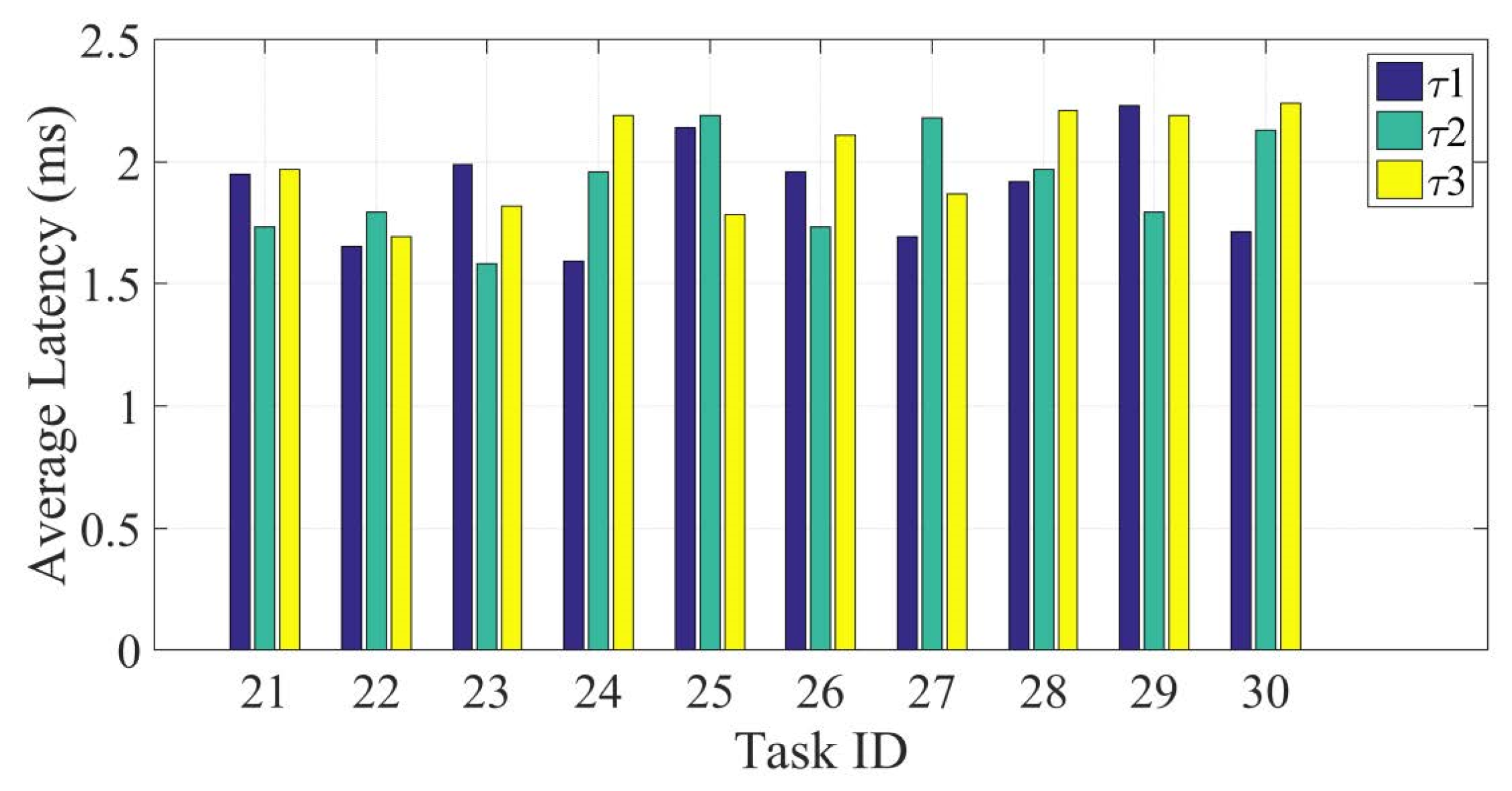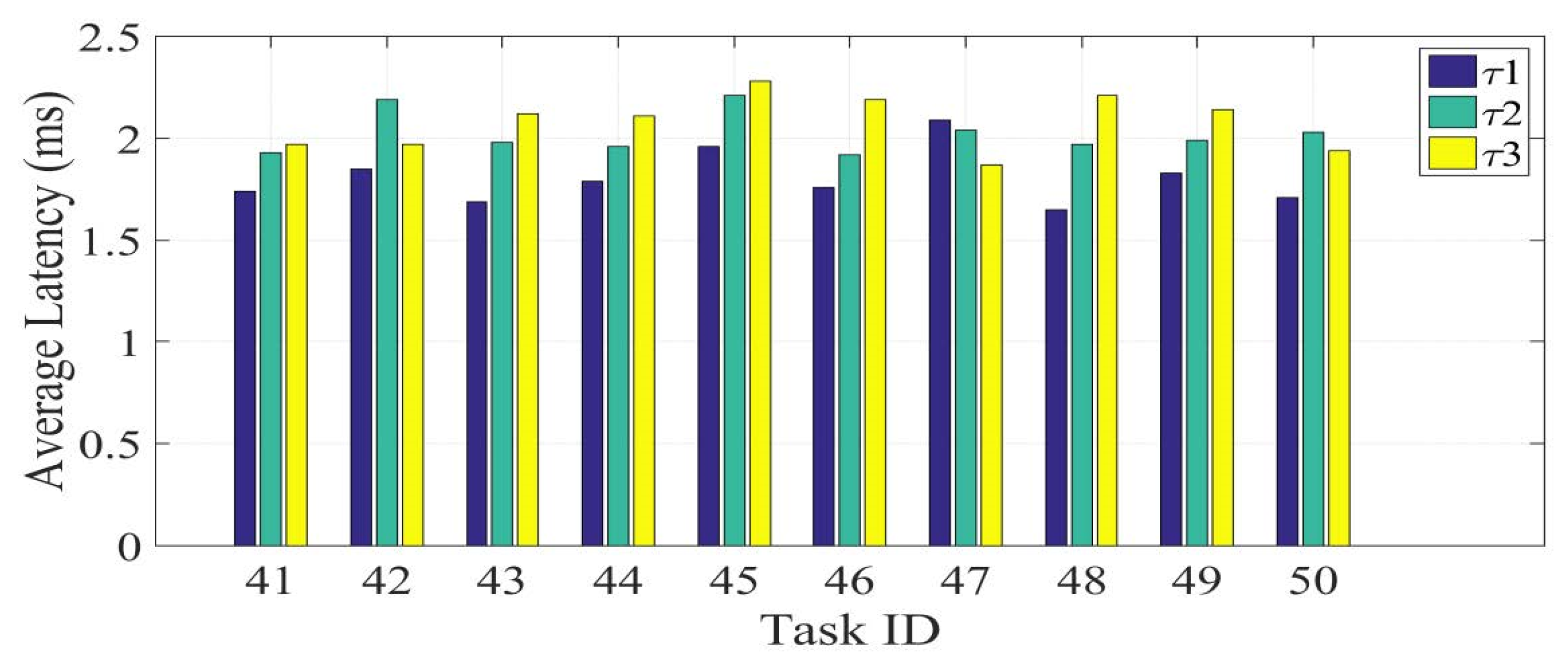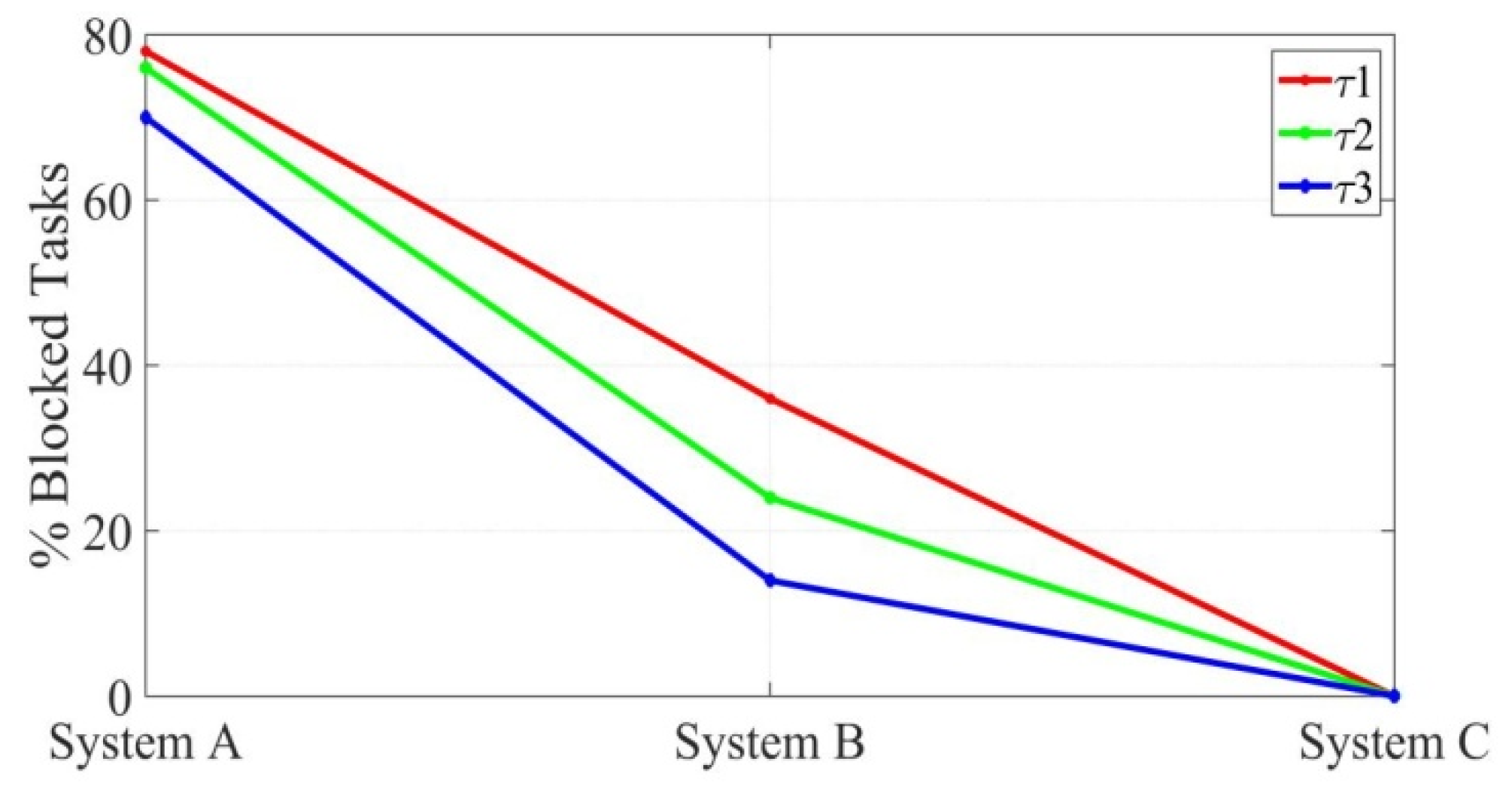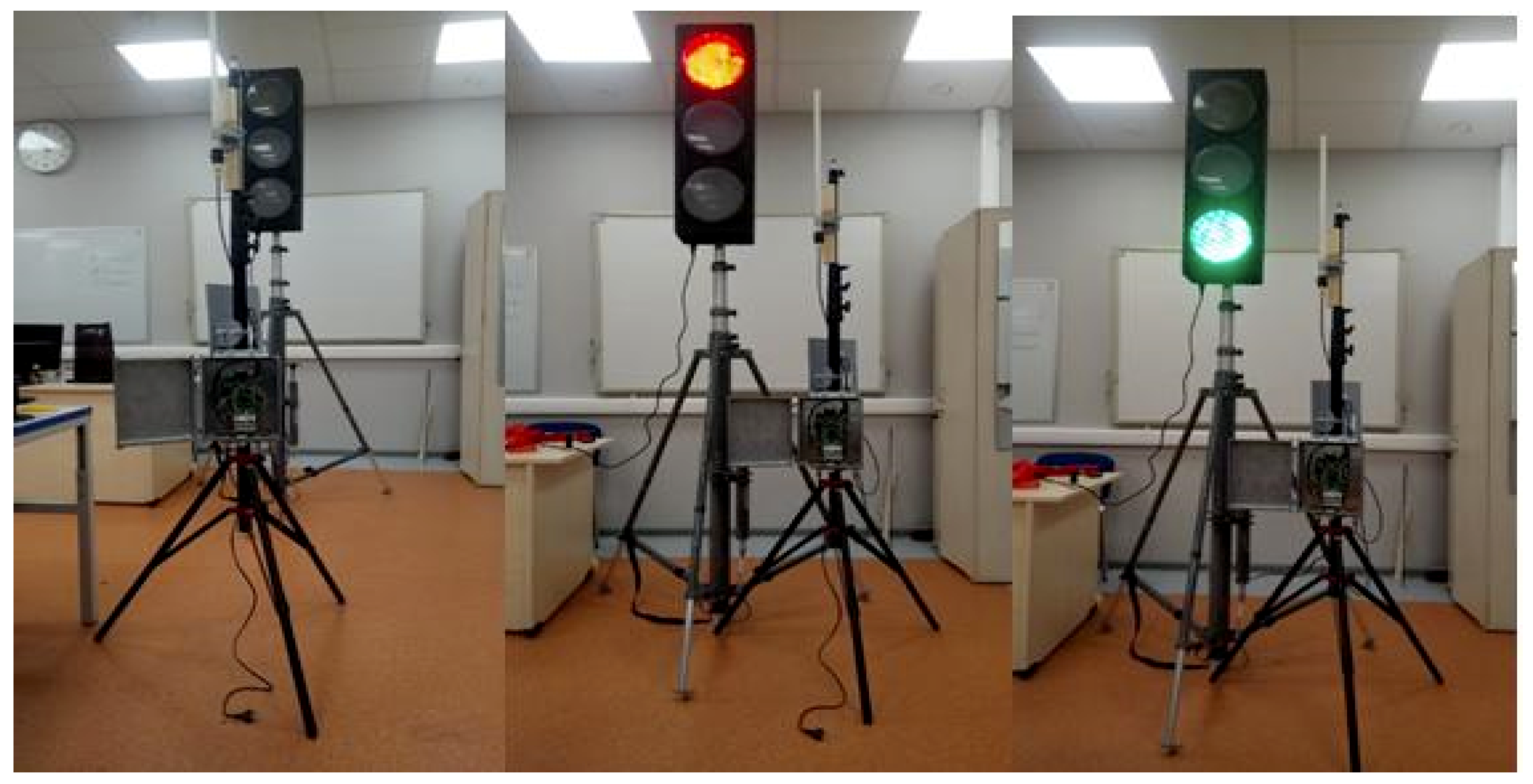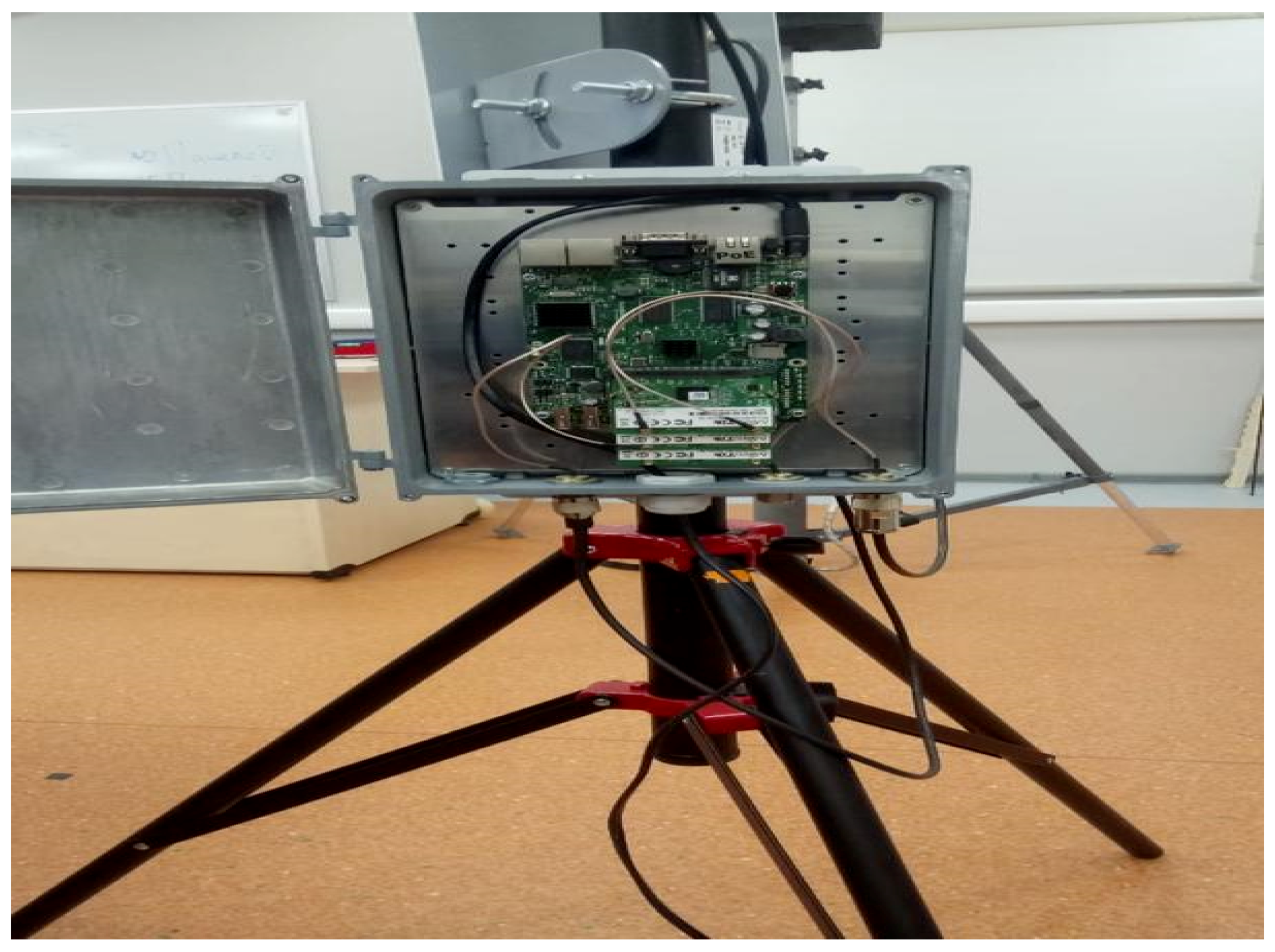1. Introduction
Based on the preplanned road map announced by the International Telecommunication Union (ITU) and the Third Generation Partnership Project (3GPP), by 2020 it is expected that we will begin a new era of mobile communication systems with great and efficient capabilities with the announcement of the fifth generation of mobile communication systems (5G) [
1]. By the end of this year, standards for building the 5G cellular system with the announced requirements will be ready, and the final step in the 5G road, which is the systems implementation, will begin [
2]. With this great achievement, we will have a new era of telecommunication systems represented by the 5G system and its use cases. Each use case represents a challenge and requires certain design aspects to be realized [
3]. Most of these use cases will be available and can be implemented with the realization of the 5G system, except for intelligent transportation systems like vehicle ad hoc networks (VANETs).
The 3GPP identifies five main categories of 5G use cases, with potential services for each category [
4]. These categories can be reduced and distributed over three major verticals of 5G services. These verticals are also defined by ITU Radiocommunication Sector (ITU-R) as the three usage scenarios for 5G and beyond, which include and support a wide range of use cases, applications, and scenarios of 5G. The three main family groups of use cases include [
5,
6,
7] the following:
- 1-
Enhanced Mobile Broadband (eMBB);
- 2-
Massive Machine-Type Communications (mMTC); and
- 3-
Ultra-Reliable and Low-Latency Communications (uRLLC) including Enhanced Vehicle-to-Everything applications (eV2x).
Vehicle-to-Everything applications are one of the main 5G use cases. For eV2X services, the expected requirements are [
8]:
Reliability = 1–10–5, packet size of 300 bytes, and user plane latency of 3–10 ms (for direct communication—communication range of few meters); and
Reliability = 1–10–5, packet size of 300 bytes, and user plane latency of 3–10 ms (packet is relayed by the base station).
Nowadays, the telecommunications industry is showing significant progress in its development. In recent years, a large number of modern technologies that can cope with a wide range of tasks have been developed, tested, and implemented. Achievements in modern science toward the development of hardware, software, and interaction technologies allow us to design and implement a wide range of different telecommunication networks.
A clear example of technologies that have been rapidly developing in recent years are Intelligent Transportation Systems (ITSs) [
9]. ITSs are being introduced everywhere as they have huge potential for improving the safety and efficiency of road traffic, as well as the comfort of the population. ITSs support multiple communication interfaces between network infrastructure devices: Interaction between vehicles—Vehicle-2-Vehicle; interaction between vehicles and network infrastructure—Vehicle-2-Infrastructure; interaction between vehicles and cloud systems—Vehicle-2-Cloud; and interaction between vehicles and pedestrians (including cyclists)—Vehicle-2-Pedestrian [
10]. Such a set of interactions allows a complex and prompt response to changes in the network state and the location of all its participants, which ultimately increases the relevance of ITSs for modern cities [
11].
The development of modern transport systems is not only based on improving road safety, and the scaling of network and transport infrastructure, but also on creating a competent management complex. To the forefront come such aspects of ITSs function as the security of transmitted information, the current growth rate of the number of network users, the continuous growth of network traffic, and many other factors [
12]. To localize these tasks and a number of other well-known bottlenecks of ITSs, it is necessary to develop an efficient architecture that will cope with the load generated by network elements, manage traffic flows correctly and in a timely manner, conduct uninterrupted statistical analysis, and meet the standards and requirements of modern communication networks [
13].
ITSs are at the center of the closest contact between the automotive industry and information technology industries. The use of ITS has developed a special environment in which management, operation, and maintenance can advance [
14].
Designing of ITS and VANETs faces many challenges, due to many constraints that comes from the special requirements of applications run over such networks, and the massive amount of traffic. Today, VANETs support a large number of new services and protocols. Nevertheless, there are still a number of challenges that impede the full implementation of this technology in real life [
15]. These challenges include the following [
16]:
(a) Problems ensuring noise immunity
In transport networks, VANETs receive a large amount of interferences of different types. The effect of interference can be maximized by choosing the optimal channel frequency or by adjusting the power of the receivers and transmitters of the devices in the network. However, in classical VANETs, this problem remains unresolved and has a significant impact on the network operation [
17].
(b) Problems ensuring the security of transmitted data
The main causes of problems related to the information security of VANET transport networks are [
18]:
The lack of means to protect nodes from intruders and hackers;
The ability to listen to the channels and the substitution of messages due to the general availability of the transmission medium;
The inability to apply a classical security system due to the peculiarities of the classical architecture of the VANETs;
The need to use complex routing algorithms that take into account the likelihood of incorrect information from compromised nodes as a result of changes in the network topology;
The inability to implement a security policy due to the peculiarities of the classical architecture of VANETs, such as the absence of a fixed topology and central nodes.
(c) Problems in routing efficiency
In VANETs, the bandwidth problem is most acute with the simultaneous transmission of large amounts of video information. The situation is worsened by the inefficiency of routing methods when the network becomes overwhelmed with broadcast requests or a bottleneck is formed [
19].
Traditional VANETs are characterized by maximum decentralization with no dedicated server in the network, and the entire infrastructure is distributed to communication centers. This feature brings the following disadvantages; low mobilization abilities and long system response time to external influences [
20,
21].
The obvious solution is to deploy new technologies to overcome these challenges and achieves the requirements of the VANETs. Mobile edge computing (MEC) and software defined networking (SDN) are recent technologies that can provide a novel solution to build a reliable VANET systems with ultra-low latency [
22,
23]. The concept of SDN is a relatively new technology that has already been widely used to manage modern networks. SDN technology is based on the principle of separation of the control level (control plane) and data transmission (data plane), which makes it possible to efficiently use network bandwidth for transmission of statistical information and control messages [
24]. Besides this, it manages the network architecture by its routing of a separate element—the SDN controller, which significantly simplifies both the network architecture and hardware design.
MEC is another recent communication paradigm that has been established by cellular network operators to provide the computing capabilities at the edge of radio access networks (RANs) [
25]. MEC represents a distributed scheme from the traditional centralized scheme of cloud computing that achieves higher latency efficiency for performing computing tasks, since the distance between the end user and the MEC server is one or two communication hops [
26]. The introduction of MEC servers at the edge of RAN achieves many benefits beside the reduction of round-trip latency; these benefits include the following [
23,
24,
25,
26]:
- 1-
Achieving higher spectral efficiency;
- 2-
Reduction of traffic congestion at the core network;
- 3-
Reduction of round-trip latency;
- 4-
Innovation of new services; and
- 5-
Achieving higher system reliability.
Our SDN-Lab proposed an intelligent core network for Tactile Internet in [
24,
25,
26,
27], that deploys distributed SDN controllers with distributed OpenFlow switches to manage and control the whole network. The system achieves many benefits for 5G based systems, especially for high traffic density networks. Moreover, we developed a multilevel MEC system in [
23,
26], for Tactile Internet and ultra-low latency 5G applications. The system deploys heterogeneous edge servers to provide the computing capabilities at the edge of a RAN, one communication hop away from the end user. The multilevel MEC system can be deployed side by side with the intelligent core networks for VANETs.
The main contribution of this work is to provide a VANET system based on multilevel MEC system and SDN technology. The system achieves high latency efficiency, due to the deployment of MEC technology. Also, the proposed system solves the problem of high traffic density and reduces the congestion of the core network. Moreover, the system achieves higher reliability efficiency. The offloading algorithm for managing and controlling traffic flow from vehicles to edge servers is developed in a way to achieve higher latency efficiency.
Section 2 introduces the related works that are most relevant to our proposed system and the novelty of the proposed structure compared to these systems is introduced.
Section 3 provides the proposed system structure. In
Section 4, the developed latency-aware offloading algorithm is introduced for the proposed structure.
Section 5 provides the experimental evaluation of the proposed system and the developed algorithm. In
Section 6, the realized system is introduced.
2. Related Works
Currently, research in the field of alternative methods of transport network management is gaining momentum. With the near release of 5G and the current innovations of the IoT system, designing a robust and reliable VANET, with ultra-low latency applications has become a demand [
28]. Much research considering VANET system level design and design challenges has been conducted. In this part, we consider the most recent and related works to our proposed system. Furthermore, the novelty of the proposed work compared to these works is presented.
A group of researchers from University of Toulouse reviewed the SDN hybrid architecture for ITS management [
29]. The key idea of this architecture is the hybrid control level, which includes the base station controller of the mobile network and a controller of roadside unit (RSU) modules, as well as a central controller to coordinate the actions of different controllers. The central controller creates a global view of the network infrastructure by sending information to the controller of each network with data in the cloud. It sends each controller global rules describing the general behavior of the network, while BS and RSU controllers define specific rules that must be set in each network device. Communication between SDN controllers is performed using a special interface, known as East–West; communication between SDN controllers and the cloud is performed through Application Programming Interfaces (API).
The aim of the experiment was to demonstrate how a global view of the network, combined and enriched with information obtained from the cloud, allows us to more effectively manage network behavior by ultimately providing a service with increased performance. However, this work did not consider the deployment of MEC technology, which represents a main part of our proposed system. This system was mainly dedicated to network management and flexibility at the application layer, while our proposed structure mainly considers traffic management and enhancing routing efficiency by the introduction of MEC servers controlled by an SDN network.
Another research project on this subject comes from the work group from the University of Singapore (School of Electrical and Electronic Engineering Nanyang Technological University, Singapore) [
30]. This approach also involved the use of existing mobile network architecture in addition to the implementation of management based on SDN technology. It should be noted that all VANET architecture is divided into segments (Control Regions) which may contain a certain amount of RSUs and which operate a control member (Local Controller); this significantly reduces the delay in the case of transmission of information to the network management unit.
The central network controller is located in its core. The interaction between the central controller and local controllers takes place based on a mobile communication network. The authors called this architecture SDVN—Software-Defined Vehicular Network.
The key parameter chosen in this paper for the simulation and mathematical models was delay. For comparison, three network architectures were selected: A VANET based on the ad hoc on-demand distance vector (AODV) routing protocol, SDVN with a central controller, and SDVN with controllers located within the segments. This work shares the similarity of deploying SDN paradigm with our proposed work. However, we introduce the MEC technology as a main part of our proposed structure, which achieves various benefits in terms of latency and data offloading. Furthermore, this work only presents a structure of the core network with no performance evaluation.
In [
31], the authors proposed a context-aware packet-forwarding mechanism for information-centric networking (ICN) based VANETs. The relative geographical position of vehicles, the density and relative distribution of vehicles, and the priority of content were considered during the packet forwarding.
In [
32], the authors focused on a vehicle-to-vehicle communication system operating at a road intersection, where the communication links can be either line-of-sight (LOS) or non-line-of-sight (NLOS). The authors presented a semi-empirical analysis of the packet delivery ratio of dedicated short-range communication (DSRC) safety messages for both LOS and NLOS scenarios using a commercial transceiver.
The authors of [
33] critically reviewed the existing methods of adaptive traffic signal control in a connected vehicle environment and compared the advantages and disadvantages of those methods.
The proposed architecture provides load balancing between distributed controllers and uses a local view of the network to make better decisions. Both the theoretical model and the simulation results confirmed that the proposed SDVN architecture differs from the existing SDVN with a central controller in terms of latency. The proposed system has the same low latency as the existing VANET.
3. System Structure
In this part the proposed structure for a novel VANET system is introduced. The system comprises two main technologies; SDN technology at the core network and MEC at the RAN. Introducing an SDN paradigm to the VANET became a demand, since it achieves various benefits that include the higher security, latency performance improvement, network congestion reduction and higher routing efficiency. MEC technology provides computing capabilities near to vehicles, which reduces the communication latency and solves the problem of high traffic density. With the introduction of SDN and MEC technologies, traffic from vehicles does not have to pass through the network core; it can be managed and handled at the edge of the access network.
Figure 1a provides the general structure of the VANET system. The system deploys distributed stationary roadside units (RSUs) to assist vehicles. The core network provides an interface to the application server that provides additional services for the vehicles. Vehicles interact with each other, i.e., V2V, and with surroundings, e.g., V2X, over the appropriate reliable radio access interface, e.g., dedicated short range communication (DSRC) and cellular V2X (C-V2X) [
34]. DSRC are based on the IEEE 802.11 standard group, which have been modified for vehicular communication. The IEEE 802.11p is the most common radio access technology that has been developed for Mobile ad hoc networks (MANETs), including ad hoc networks for vehicles [
35]. The physical layer and the MAC layer of the IEEE 802.11P have been derived from the IEEE 802.11a standard.
The technical requirements of the IEEE 802.11p standard are targeted to speed up to 200 km/h, response time around 100 ms and a communication range of up to 1 km. IEEE 802.11P provides unacceptable performance for ultra-low latency applications, which makes it proper only for safety applications [
34,
36]. Furthermore, for high density vehicular networks, IEEE 802.11P indicates low performance due to packet collision. This makes the C-V2X more desirable for these applications. To overcome these limitations of the IEEE 802.11.P, and to increase the performance of DSRC compared to that of C-V2X, a new radio access protocol, i.e., IEEE 802.11bd, has been developed. IEEE 802.11bd offers higher modes of operation at a higher throughput.
One of the main design goals of the IEEE 802.11bd was to achieve a throughput at least twice that of IEEE 802.11P at a higher mobility, i.e., the targeted speed of up to 500 km/h. Furthermore, another main advantage of 802.11bd is increasing the communication distance to double of that covered by the IEEE 802.11P. However, IEEE 802.11bd achieves higher benefits and performance compared to the IEEE 802.11P, the main problem associated with the deployment of the 802.11bd is the compatibility with existing systems [
36].
The proposed system introduces the multilevel MEC structure and an intelligent core network to the general VANET system structure, as illustrated in
Figure 1b. The proposed system comprises three types of communications. The first is the communication between vehicles and referred to as the vehicle-to-vehicle (V2V) communication. The second interaction is the data transferred between vehicles and stationary road infrastructure, i.e., RSU, and is referred as vehicle-to-infrastructure (V2I) communication. The third communication may be hold between vehicles and other surrounding devices, which is referred to as vehicle-to-everything (V2X). These communications are done over appropriate communication interfaces, such as the IEEE 802.11 standard group.
The proposed VANET structure can be viewed as a four layer system, as presented in
Figure 2. The first layer represents the physical hardware layer that includes vehicles powered with On-Board Units (OBUs) able to communicate with the distributed RSUs. RSUs are centralized remote management units that are responsible for forwarding and exchanging service control packages. The second layer represents the heterogeneous edge cloud servers deployed at the edge of the RAN. Two main types of MEC servers are considered for the proposed system; micro-cloud edge servers and mini-cloud edge servers. Each RSU is connected to a micro-cloud edge server, as well as the cellular base stations. The micro-cloud edge server is powered with limited computing and energy capabilities. Each group of micro-cloud servers are connected with a mini-cloud edge server, with higher computing and energy resources.
The third layer represents the SDN network deployed at the core network. This layer contains two main sub-layers; data plane sub-layer and control plane layer. The data plane layer contains distributed OpenFlow switches that support the appropriate version of the OpenFlow protocol. The control plane contains distributed SDN controllers that control and manage the whole network. The SDN network is managed via application programming interfaces (APIs). The core network provides an interface to the higher layer that represents the application server.
The proposed system provides two main network interfaces at the first layer. The first interface is the car-car and the second is the car-infrastructure network. This can be done over the appropriate IEEE 802.11 communication interface, as previously introduced. The distributed edge servers in the second layers are connected over a high speed fiber wireless (FiWi) network [
37].
Where, each RSU station is connected to a MEC server to provide the computing capabilities at the edge of the access network. This in turn, offloads the data and reduces the traffic passed to the core network, which reduces network congestion and packet loss.
